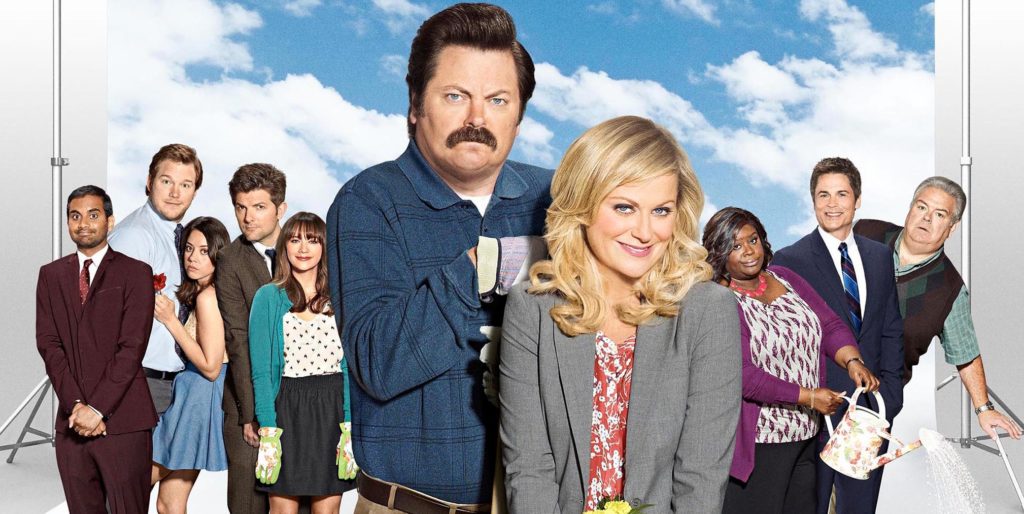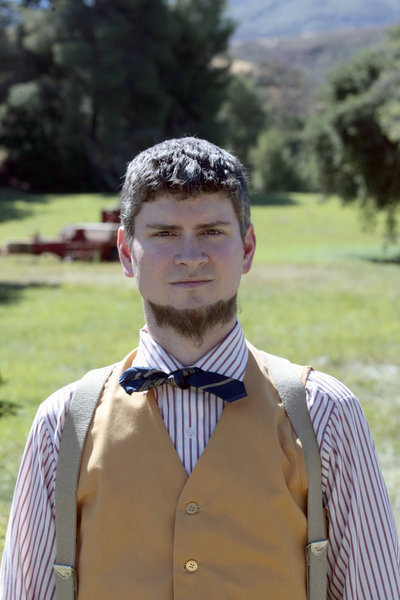
Sitcom legend Michael Schur has redefined the sitcom as we know it, playing an integral role behind the scenes of The Office (US), Parks and Recreation, Brooklyn Nine-Nine and The Good Place.
Ahead of a special Parks and Recreation reunion episode this week, which was written and produced by Schur, we take a closer look at just what makes his work click.
WORLD-BUILDING
Schur’s shows start with a simple idea; a premise that, as the story progresses, expands into a world of possibility. While story is Schur’s primary objective, diegetic elements are slowly sprinkled in to create the sense of a larger world. He plans out his projects to the most finite detail to leave no thread dangling. There are reasons as to why the Harry Potter franchise is successful; the experience of watching these films is an opportunity to become immersed in their fantasy worlds. And like Hogwarts is Harry, Pawnee is to Parks and Recreation.
During Parks and Recreation‘s first season, Schur introduces the viewers to Pawnee, Indiana. At the completion of the program, the audience is familiar with the fundamental locations in the city; JJ’s Diner, the City Hall, amongst several others. As the show progresses, Leslie Knope (Amy Poehler) reveals the feud between Pawnee and Eagleton, the significance of the Sweetums factory to Pawnee’s history, and artistic depictions of the mistreatment of the native Wamapoke Tribe by invaders. And to Ben Wyatt’s (Adam Scott) confusion, the entire city adores miniature horse Li’l Sebastian.
Similarly, in The Good Place, it is explained that there is a Good and a Bad Place, and that good people go to the Good Place and bad people go to the Bad Place. Throughout the duration of the program, this reality is expanded to include the Medium Place, the cosmic judge who determines the fate of humanity, and the infinitude of diverse Janets.
Schur treats the narrative as its own entity; an organism that is constantly growing and evolving, allowing the audience to lose themselves in the plot through character experiences on screen.
CHARACTERS

Michael Schur as Mose in ‘The Office’. Photo by Chris Haston/NBC
Every successful television series needs a strong ensemble of characters. Michael Schur creates iconic characters with heart and depth, moulding the character interactions to create wholesome moments amongst the comedic routines.
Schur was heavily involved with the formulation of Jim and Pam’s (John Krasinski and Jenna Fischer) relationship, which is heavily referenced as the heart of The Office. On Parks and Recreation, Schur scribed the characters in a specific way to convey a familial sense of love toward each other. Instead of placing emphasis on any character, Schur elected to write jokes based on situations and the environment. While Jerry (Jim O’Heir) was often the victim of banter, underneath the jokes, the characters genuinely loved him.
Schur’s characters are first introduced as standard archetypes but evolve into much deeper and fleshed-out individuals. Character development is a major component to writing a successful role, and by watching the loner Ron Swanson (Nick Offerman) become comfortable and learn that he needs others to dissipate his loneliness, it is evident that Schur knows how to write a deep, compelling character.
By watching these shows, the audience falls in love with the characters, becoming invested in their lives as they would a friend or family members. Schur’s distinct ways of showing his characters at their highest highs and their lowest lows resonate with the audience, creating a strong emotional bond between fiction and non-fiction.
Schur’s characters are widely recognised as the golden standard of sitcom characters, and with icons such as Brooklyn Nine-Nine‘s Captain Holt (Andre Braugher) and Rosa Diaz (Stephanie Beatriz) and The Good Place‘s Tahani (Jameela Jamil), Michael the architect (Ted Danson) and almost every character on The Office, it’s hard to deny their appeal. And with expressions such as “Treat Yo Self”, “Noice”, and “Why are you the way that you are?” conceived on Schur’s projects, the iconic status of these characters transcends the programs themselves to influence people who have never watched these shows.
COMEDY STYLE & THE AUTEUR THEORY
Though mainstream today, Schur’s comedic style was revolutionary when first established in The Office and Parks and Recreation. His approach allows him to express his artistic vision while maintaining the comedy style that has been successful throughout his portfolio.
An auteur is a person who implements their distinct creative vision across their bodies of works, to the point that it is indistinguishably their own. A term typically reserved for film directors, Schur possesses attributes of an auteur, as his workplace mockumentary/shaky cam style is projected across his many television series. Schur implements a “joke-per-minute” comedy, ensuring that the audience is thoroughly entertained whilst immersed in the narrative.
Collaboration is a major component to bringing his projects to life; Allison Jones is the casting director across Schur’s entire portfolio, and actors are often reused across different programs in various roles. Schur also writes his characters to fit the actors portraying them; Brooklyn Nine-Nine‘s Terry Jeffords was written specifically for Terry Crews, and Ted Danson and Kristin Bell were hired for The Good Place before the characters had been created. Similarly, Schur broadens his characters by applying qualities the actors possess; Ron Swanson is very different to Nick Offerman, though both have a passion for the saxophone and woodworking.
While any author can write a punchline, Schur takes it one step further and encourages the cast to film “fun runs” of the scenes. This is where the actors improvise jokes to evoke the best reaction from the audience. One of the best jokes in Parks and Recreation is constructed solely from Chris Pratt’s improvisation (Timestamp: 0:48-1:54):
Schur’s comedy style is not too over the top; he likes to maintain a sense of reality and relevance to his humour to appeal to a variety of audiences. As an auteur, Schur dabbles with the archetypes generally associated with sitcoms, but isn’t afraid to deepen the characters, setting, and jokes to keep his stories fresh and original.
CONTINUITY & OVERARCHING STORYLINES
Prior to filming, Schur constructs a roadmap of the journey he wants to take both the characters and audience on. He writes ‘show Bibles’ for his different programs, where the record of every fact about the respective series is found. With the destination planned out, Schur can enhance the journey, resulting in a more enriching story with call-backs and focus on character development. Typically reserved for dramas consisting of hour-long episodes, Schur’s projects utilise the concept of an overarching storyline that can span a plot over the course of multiple episodes. This allows each season to feature a prominent structure, creating a more complex narrative.
The entirety of The Good Place is an enormous overarching narrative, with each episode broadening the story and building to the explosive destination. The fourth season of Parks and Recreation focuses on the city council election and different means of pandering to the public. And while Brooklyn Nine-Nine generally avoids season-long story arcs, there are multiple instances where the season is split into several three-to-four episode mini-arcs that develop the proceeding plot.
This pre-planning enables a greater sense of continuity; minor elements that occur in early episodes are often brought back in later episodes to be properly expanded, such as NutriBoom in Brooklyn Nine-Nine. Schur likes to leave no stone unturned, which assists in ensuring continuity is maintained.
THEMES
A major appeal to Schur’s projects is that audiences can resonate with the characters and scenarios. He takes environments that are typically clouded in negative stigmas; workplace, government, and police stations – and adds heart, humour, and positivity to form a bond with the viewer. This allows common perceptions to be subverted, depicting a more human element to alter the viewer’s impressions.
Though comedy and narrative are the soul of these shows, Schur does dabble with societal issues from time to time. Brooklyn Nine-Nine features episodes highlighting the consequences of racism, misogyny and more, whereas Parks and Recreation tackles Pawnee’s reaction to women in a government role. These programs address these themes as serious issues and deviate from happy endings to depict the unfair resolutions similar circumstances have in society.
Each show in Schur’s portfolio has its own overarching theme across the entire series; The Good Place’s focuses on what it means to be a good person, Parks and Recreation showcases the importance of friendship, and Brooklyn Nine-Nine emphasises the prominence of relationships with others and the significance in working as a team. Each show, however, advertises a common thread; it is essential to adapt and evolve with the people in your lives, and is reinforced through character’s learning to work as a unit rather than a single entity.
REWATCHABILITY
There are many reasons why The Office, Parks and Recreation, The Good Place and Brooklyn Nine-Nine are admired on an international basis, but one element stands separate; these programs are so rewatchable. Due to the creative collaborative process that goes into creating these projects, the audience picks up on something that they previously missed with each viewing. The jokes are written in a distinct style that transcends time and are enjoyable after multiple viewings. The heart-warming character relationships and enriching narrative are reason alone to return.
Due to his creative control and depth of understanding; Shur knows when to call it quits. Rather than jumping the shark and dragging a show on past its expiration date, he will finish a project on his own terms to maintain its integrity and value. This has created some of the more beautiful series finales in television history; Parks and Recreation’s One Last Ride and The Good Place’s Whenever You’re Ready.
FINAL THOUGHTS
These shows aren’t designed to be cult classics. Schur is an artist and creates shows to convey a message; to resonate with the general audience by warming the viewer’s hearts and encouraging deeper philosophical and societal thinking.
Though it can be hard to imagine any other project being quite as iconic as The Office or Brooklyn Nine-Nine, Schur has proven time and time again that his formula works. Schur’s name is gold, and his portfolio continues to transcend time and appeal to new audiences every year.
There has never been a better time to introduce yo’ self or rediscover Michael Schur’s career. If you’re looking for a good laugh, put on The Office. To lose yourself in the narrative and become invested with enriching characters, give Parks and Recreation a try. To become immensely satisfied with a heartfelt arc and learn about philosophical questions, binge The Good Place. And if you want all three tied in one neat package, re-watch Brooklyn Nine-Nine.
Treat yo’self to a plate of 🧇’s for this one. https://t.co/AQ91Vs3VAW— Parks and Recreation (@parksandrecnbc) April 24, 2020









